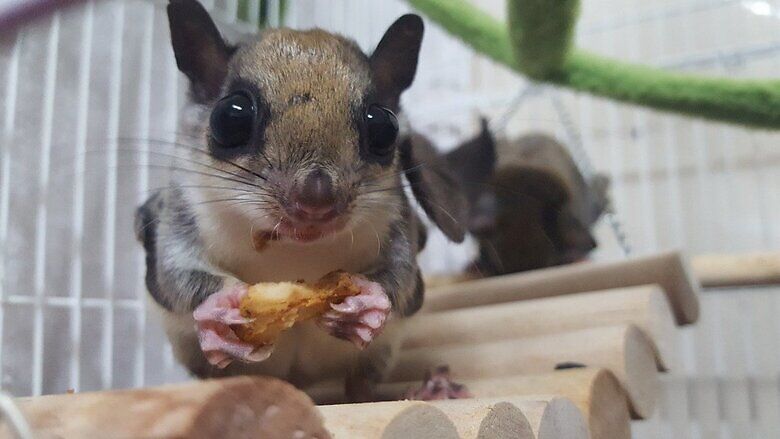Different Ways to Get Rid of Flying Squirrels
As fuzzy and adorable as flying squirrels might be, a colony of them nesting in your attic can lead to problems, such as health risks, gnawed boarding, and fire hazards.
There’s more than one way to get rid of flying squirrels, including prevention, removing food sources, exclusion, and trapping. Employing more than one method will get you the best results, but only if you know what you’re doing. If you don’t want to hire an expert to do it for you, you’ll need to learn a little bit more about flying squirrels and how to get rid of them.

Prevention
Flying Squirrels are looking for two main things: food and a safe place to hide. By removing these factors from your property, your home will no longer be a place of interest to them.
Remove Food Sources
Flying squirrels have a diet that covers a wide range of foods, so limit their access to discourage them from staying.
- Don’t leave pet food out
- Secure trash cans, and don’t leave garbage bags out
- Harvest any garden fruit and vegetables as they ripen
- Clean up any fallen fruit, nuts or seeds from trees
- Use a squirrel-proof bird feeder and clean up fallen seed
Keep Them Out
Removing potential food sources is just one aspect of squirrel prevention. If you want to prevent them from nesting in your home, you’ll need to use physical barriers.
- Prune tree limbs back to six to eight feet away from the house where possible.
- Inspect the building for any holes or gaps ½ inch wide or larger and seal them with steel mesh.
- If you have a chimney, install a chimney cap. Likewise, any vents should have covers.
Trapping
If you already have flying squirrels living in your attic, then prevention methods won’t work.
Your best option is to call a wildlife removal expert, but if you want to do it yourself, then use a repeater trap placed in the attic.
- Before using a trap, it’s essential to contact your State Department of Fish and Wildlife to learn the regulations regarding trapping and relocation of flying squirrels.
- Bait the trap for a couple of days without setting it, so that the squirrels become used to it.
- When you do set the trap, you should be able to catch the whole colony. If you try setting the trap from day one, you might be able to catch one or two squirrels, but the rest will learn to stay away.
- Some of the most effective baits include peanut butter, sunflower seeds, or fruit.
If trapping isn’t the right option for you, exclusion doors are an effective alternative.
Exclusion doors, when installed correctly, are a means of letting an animal out of an area but don’t allow them to come back in.
- Work out the main entrance that your flying squirrels are using to get in and out of your attic.
- Install an exclusion door over that hole and seal all others up.
- Once the flying squirrels leave to find food, they won’t be able to come back in.
Repellents
There are many types of repellents available for squirrels, including flying squirrels. None have proved to be effective. Most repellents are supposed to repel the animal using scents, which is why they are ineffective. Flying squirrels have a lot of predators and need a safe hiding place to rest. When faced with the option of dealing with an unpleasant smell, or leaving safety to risk being eaten, they stay and put up with the scent.
- Mothballs – While not a commercial squirrel repellent, mothballs are an often-recommended option. However, it’s just as ineffective at deterring the flying squirrels and can cause respiratory problems and other adverse health side effects due to their high toxicity.
- Flashing Lights – Flashing lights installed in the attic are another commonly recommended DIY repellent. However, flying squirrels are so small, and attics are so full of crevices and hiding places, that the squirrels will just tuck away in a corner where the light doesn’t bother them.
- Ultrasonic Emitters – These have already been declared fraudulent by the Federal Trade Commission, so don’t waste your money on them.
Don’t Kill
1. They’re Important
Flying squirrels are a vital part of the ecosystem: as they facilitate the planting of new trees (through their buried seed caches). They also help to keep insect and mice populations down, as both are part of their diet.
2. It May Be Illegal
Some species of flying squirrels are listed as endangered, making it illegal to kill them. So even if you aren’t too worried about the benefits flying squirrels bring to your neighborhood, you should withhold from taking lethal action.
3. Poisons are Inhumane
If you are thinking about using poisons, remember that it is a slow and painful way to kill an animal. The flying squirrels will crawl away somewhere safe while it hopes to recover, which means that it will die in some small cavity of your home. Instead of a live flying squirrel that you’re trying to remove, you’ll now be stuck with the stench of a decaying body, that you might not be able to access.
